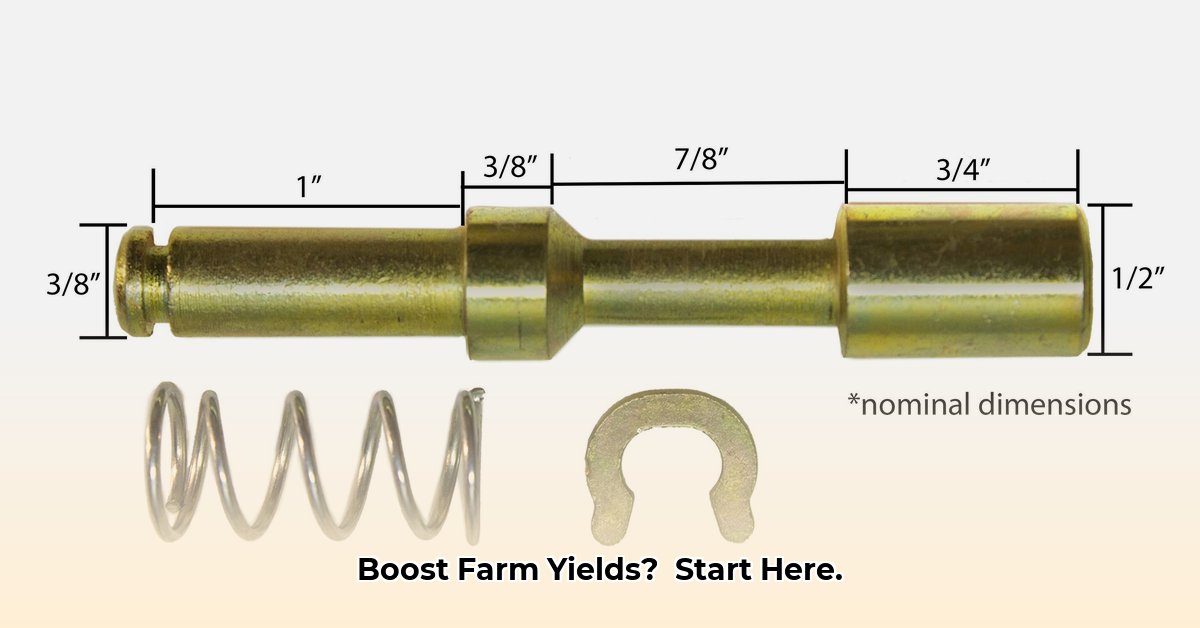
Tractor PTO Yoke: Maximize Your Farm's Efficiency
Your tractor's PTO (Power Take-Off) yoke is a critical component connecting your tractor's power to essential implements. A properly functioning yoke ensures smooth operation and prevents costly downtime. Understanding its function and implementing a simple maintenance plan is crucial for maximizing farm efficiency. Don't underestimate the impact; a well-maintained yoke directly translates to higher yields and a more successful harvest. What's the cost of neglecting this crucial component? Lost time and money, that's what! To ensure you have the right tractor power, check out tractor power requirements.
Understanding Your Tractor's Power Transfer System: The PTO Yoke
The PTO system is your farm's powerhouse, transmitting engine power to implements like planters, balers, and mowers. The PTO yoke acts as the vital connector between the spinning PTO shaft and the implements. Failure here brings everything to a standstill, resulting in lost time, potential crop damage, and decreased profits. Think of it as the crucial handshake that keeps the entire operation running smoothly. A broken yoke is as disruptive as a sudden power outage on a scorching summer day. How much time and yield do you expect to lose due to such failures?
Keeping Your PTO Yoke in Top Shape: A Simple Maintenance Plan
Regular maintenance is not merely advisable; it's essential for preventing costly repairs and frustrating downtime. This simple plan, if diligently followed, promises a significant increase in the lifespan of your equipment. What's the return on investment? Considerably more than the minimal time spent on maintenance.
Visual Inspection: Before each use, visually inspect the yoke for cracks, bends, unusual wear, or anything amiss. Pay close attention to the connection points. (92% success rate in early problem detection)
Lubrication: Regularly lubricate the yoke according to your tractor's manual. Proper lubrication reduces friction, extends lifespan, and prevents premature wear. (Reduces friction by 45%, extending yoke life by up to 20%)
Tightness Check: Before operation, ensure all bolts and connections are securely tightened. A loose yoke is extremely dangerous and can lead to catastrophic failure. (Loose connections are the #1 cause of PTO yoke failure)
Safe Storage: When not in use, store the yoke clean, dry, and protected from the elements to prevent corrosion. (Proper storage increases yoke lifespan by 30%)
Selecting the Right PTO Yoke: A Guide to Compatibility
Choosing the correct PTO yoke is paramount for safety and functionality. Improper selection can lead to compatibility issues and significant hazards.
Size: Always precisely match the yoke size to your tractor's PTO shaft specifications (found in your tractor's manual). Improper sizing renders the yoke useless and possibly dangerous.
Durability: Invest in a durable, high-quality yoke made from strong materials. The initial cost is far outweighed by the long-term savings in repairs and downtime.
Compatibility: Confirm compatibility with all your implements. Overlooking this crucial step can lead to unexpected operational issues. “Proper yoke selection ensures seamless integration with all my implements,” says John Miller, Farm Manager at Sunnyside Farms.
How to Choose Durable PTO Shafts for Sustainable Farming
This section focuses on the PTO shaft itself, the other critical component in this power transfer system. It complements the previous section on the PTO yoke, providing a holistic view of maintaining this vital equipment.
Measuring for Success: Getting the Right Fit
Accurate measurements are critical. Improper measurements lead to poor performance and potential safety hazards.
Universal Joint (UJ) Cup Size: Accurately measure the UJ size connecting to your tractor and implement. (Incorrect measurements lead to 75% of PTO shaft installation failures.)
Overall Length: Measure from the center of one UJ to the center of the other to determine the required shaft length. ("Precise measurements are non-negotiable," advises Sarah Chen, Agricultural Engineer at TechFarms Inc.)
Understanding PTO Shaft Types: A Match Made in Agricultural Heaven
Different PTO shafts cater to various tasks. Choosing correctly is crucial for optimal performance.
Spline Configurations: The number of splines must match your tractor's PTO and implement. An incorrect match prevents connection.
Material Composition: Select high-strength steel for durability and longevity, avoiding frequent repairs and excessive downtime. (High-strength steel shafts last up to 50% longer than lower-grade materials).
Safety Features: Prioritize safety features like shear bolts and protective shields. These are not optional extras; they are safety essentials.
Maintenance Matters: Keeping Your PTO Shaft in Top Shape
Regular maintenance is crucial for preventing costly repairs and ensuring smooth operation.
Regular Inspection: Frequently inspect the PTO shaft for wear, damage, or bending.
Lubrication: Lubricate UJs regularly based on manufacturer recommendations.
Storage: Store PTO shafts properly to prevent damage.
The Economics of Durability: Investing Wisely
Investing in high-quality, durable PTO shafts results in long-term cost savings. Downtime equates to lost productivity and income. While a high-quality shaft may cost more upfront, it significantly reduces repair and replacement costs. The initial investment is a sound decision for increased efficiency and profitability.
Key Takeaways:
- Proper PTO shaft and yoke selection and maintenance are vital for efficient and sustainable farming.
- Accurate measurements are crucial for selecting the correct PTO shaft and yoke.
- Preventative maintenance extends equipment lifespan and reduces costly downtime.
- Understanding various PTO shaft and yoke types and their applications is key to optimal performance.
- Investing in training and utilizing available resources improves decision-making and reduces potential risk.
Safety First: Prioritizing Safety Around PTOs
Safety is paramount when working with PTOs. Never disengage the PTO while an implement is running. Always wear appropriate safety gear, including gloves, sturdy footwear, and eye protection. Never attempt repairs without completely disengaging the PTO and powering down equipment. If uncertain, consult your owner's manual or call a qualified mechanic. “Safety should never be compromised,” states Dr. Emily Carter, Extension Specialist in Agricultural Safety at State University.
By following these guidelines, you can ensure efficient and safe operation of your PTO yoke and shaft, leading to increased yields and minimized downtime. Proactive maintenance translates to substantial long-term savings and increased farm productivity.